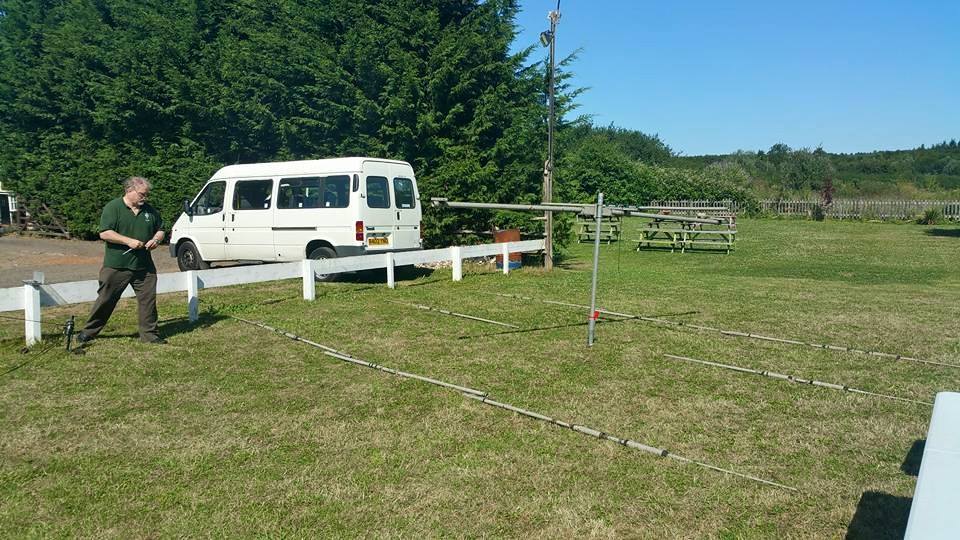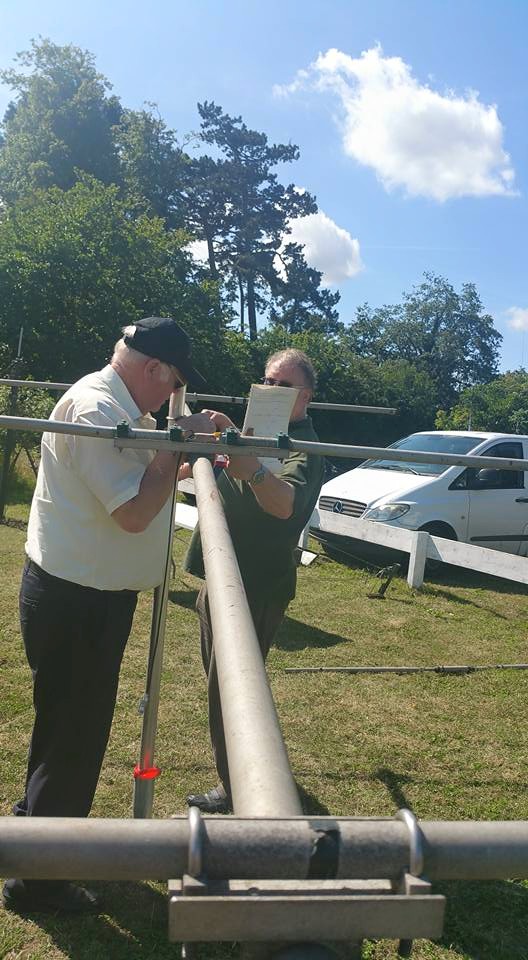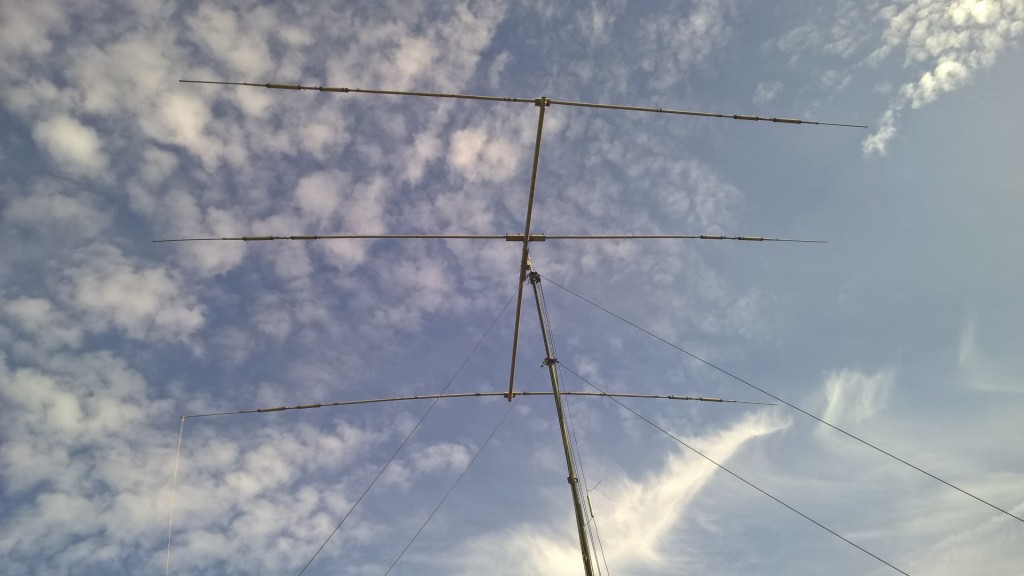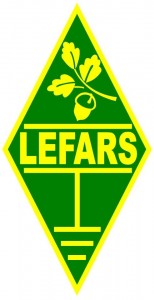How many times have you gone to a radio rally only to find loads of bits a pieces, only to find you can’t remember what you actually need for that project you have been working on? I have done it numerous times and always promised myself that I would make a list before I go next time, but then, I never do! I recently made the same mistake when going to the first summer LEFARS field day at the Rainbow & Dove. Now getting some real estate can be a bit of a lottery at these field days, but I was determined to get there as early as possible and try out my ‘new’ three element tri-bander. I recently picked up this beam from a chap in the Midlands, who used to have a monster tower in his back garden and had actually won some PW competitions with it ‘back in the day’. The problem was I did not have enough room to set the aerial up in my back garden, so I ended up trying to ‘mock it up’ by laying it out in the garden and numbering the elements. So, there we are all set, the night before I was working so got back late at night with the van full of disco gear. The last thing I felt like doing was unpacking at 2:30 in the morning and loading radio gear into the van and leaving it overnight. Next morning I was up bright and early 6am.. surely early enough, well, probably not but I pulled all the gear out and stacked the disco away and pulled out all the radio gear. In went the beam in about 10 pieces, some screw-in washing line bases (you know the ones), an ally pole for building the beam on, a few wire antennas, tool box, feeder etc.. I was planning on using the Icom IC706 that I have permanently in the van and the AT180 ATU. I had also packed my trusty Clark PU12 mast. Arriving at the Rainbow & Dove at 09:30 and I was surprised that I was one of the first there, with most of the stations setup from halfway down the field to the far end. Plenty of space for me to set up next to my Van which I parked at the corner of the car park. I feel really chuffed that there is some space in the field. Now the fun begins.. It takes over an hour to set the up mast ready to pump up. I then get to putting the Jaybeam together.
First problem (Mistake 1)… I had left my socket set at home. M0TAZ to the rescue along with M0JGR with a set of spanners. I put the beam together and realise something is not quite right. The support bracket had been mounted (by the previous owner) on the wrong part of the boom which was split into two sections (Mistake 2).
It made it impossible to get the beam to balance and get the radiator elements mounted the right distance away from either director or reflector. I took the whole thing apart again, losing one of the nuts in the grass.. I did not have my spares with me..(Mistake 3), I then, with the help of John (M0JGR) rebuilt the aerial, the right way round and set it up using the measurements in the handbook which luckily I had remembered to bring. Once put together on the pole, it was a matter of transferring it to the PU12 and pumping up the mast. To the rescue George M1GEO who helped hoof the beam up onto the small piece of pipe that I had jammed into the top of the mast as a stub. The problem was that there was not enough adjustment on the U bolts to do them up tight enough on such a small diameter stub mast (Mistake 4). I ended up improvising by finding some bits of waste wood and breaking a piece to size to shim out the stub mast to the clamp. How was I going to rotate it? I only have one rotator and it is on my tower at home (Mistake 5), so I ended up using the simple method of a piece of nylon rope to pull the aerial round. The beam certainly weather-cocked with the wind, so I has to stick something in the ground to tie the rope off to. Right the damn thing was a lot heavier than anything I put on the mast before, the heaviest I had put on there previously was my homebrew cobwebb. Some more hands came to the rescue to hump the mast up.. not extending the topmost section as I thought it was a little too thin and fragile to take the weight of the Jaybeam. Hurrah, the beam is up, the feeder is plugged into the socket on the roof of my van and the radio fired up.. Mmmm.. sounds a bit quiet. what’s the SWR like? Er, I don’t know I left the SWR meter at home by mistake (Mistake 6). The radio is showing 3:1 on 20m, 4:1 on 15m and 1.5:1 on 10m. It also appeared to be tuned for the low part of the bands, which was not ideal for SSB! John Mulye’s question: “Do you know if all the traps work?”. Er, I don’t know (Mistake 7). I did not test them before, but presumed they were OK.
How did it work? Well HF conditions were a bit poor, I spent some time listening around to get an idea of what was about, but it was only some European stations that I would normally copy on my wire antenna at home. As luck would have it I got a copy into Malta on 20m. By this time it had gone 13:00 and I was starving.. a break to go in for food. (Mistake 8) I had no breakfast so made up for it with a big lunch, at nearly £15 for a burger and a beer, it was quite expensive, even if the food was nice. Going back to the van, I sat in for a little longer to check out conditions.. I was given some advice by George.. don’t use the ATU on a beam with traps as you can damage them. With the SWR rather high I decided I did not want to risk the finals in my IC-706 so decided to call it a day, after all it was going to take me between 1 and 2 hours to pack everything down.(Mistake 9). Right so what was the upshot of this experience.. well I did learn a lot from the mistakes… From Mistake 1) Plan well in advance and make a check list.. think through everything you have to do during your expedition and make sure you list all the things you are going to need ready for loading. Load up in good time and plan the journey for a specific arrival time. From Mistake 2) Make sure you fully dry assemble an antenna before using it in anger. Make sure that all the dimensions are correct and sub assembled components have been put together correctly. From Mistake 3) If possible take spares of everything that can either break or get lost. Nothing worse than being stuck miles from home in the middle of a field not being able to do anything but for a 10p component. From Mistake 4) A bit like no 2, but make sure you have the right parts to put together in the first place. Don’t turn up presuming you can make something work. Engineering is a science, don’t think you can get by with gaffer tape, a toilet roll and some sticky-back plastic. From Mistake 5) Beams need rotating, a solution to rotate it needs to be thought out before, not made up on the spot! From Mistake 6) Setting up Aerials requires either a decent SWR meter or ideally an antenna analyser. Don’t rely on the internal swr readings from a radio or linear, they are not accurate. From Mistake 7) Test stuff before you take it into the field. It is easier to test things at home rather than in the middle of the field. After all, how are you going to fix it if it doesn’t work? From Mistake 8) Eat breakfast before you go out, take a decent packed lunch with you. It is probably better for you and easier on the wallet! (Don’t forget to take your rubbish away with you). From Mistake 9) Don’t underestimate the time required to do things. It is sometimes not worth doing something for one day, but better to schedule for two days as you can work across an entire day over two days while loosing a morning and afternoon to setting up and breaking down. Overall the whole experience demonstrated the art of preparation and planning. Some people have a set of gear that they just chuck in the car and go, others take different set-ups out with them every time, but whatever you do, plan ahead, test the important bits that must work to make the event worthwhile. As for the Jaybeam, I will have to clean it up, test the traps, buy some new hose clips, get some new nuts and a rotator & give it another go, with an antenna analyser to try it for sure!





1 Response to The byword is: Preparation